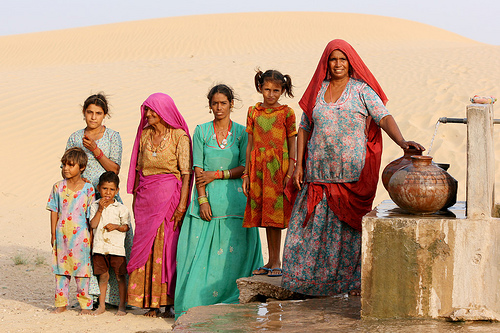Undoubtedly, the logistical and administrative implications of such a sweeping legislation and the subsidy involved would be staggering and it needs to be implemented with some hard realities in mind.
To anticipate the likely performance of NFSB, it is necessary to quantify the extent of income transfer, particularly to BPL groups, through existing nationwide social safety nets as well as some of the opportunity costs to households. This can only be done through household surveys that focus on these issues. This article reports on the results of our investigation into two of the most important social safety nets in operation: the National Rural Employment Guarantee Scheme (NREGS) and the Public Distribution System (PDS), on the basis of a representative sample, collected in 2007-08, of households in Rajasthan, Andhra Pradesh and Maharashtra. The state level rural poverty cut-off points for Rajasthan, Andhra Pradesh and Maharashtra were Rs 450.58, Rs 352.40 and Rs 435.76 per month, per person, respectively.
In Rajasthan, more than one-third of the participating households had to wait for more than 45 minutes to make purchases from fair price shops, whereas nearly 90 per cent of PDS participants in Andhra Pradesh and Maharashtra had to wait 45 minutes or less. The mean waiting time for a PDS participating household was highest in Rajasthan (more than 54 minutes), followed by Andhra Pradesh (about 30 minutes) and Maharashtra (about 24 minutes). In Rajasthan, BPL card holders had the highest mean waiting time while above the poverty line (APL) card holders had the lowest. In Andhra Pradesh, APL card holders had the lowest mean waiting time followed by BPL and Antodaya card holders. In Maharashtra, BPL cardholders had the highest mean waiting time followed by APL and Antodaya cardholders.
For wheat, real mean income transferred per household per month (RIT) was the highest for Rajasthan (Rs 9.44), followed by Maharashtra (Rs 4.59). Mean RIT for acutely poor participants in wheat consumption was nearly the same in both states; however, it was significantly higher in Rajasthan for moderately poor, moderately non-poor and affluent participants. In Rajasthan, mean RIT was highest for affluent and lowest for acutely poor households. In the case of rice, Andhra Pradesh had the highest mean RIT (Rs. 7.38), followed by Maharashtra (Rs. 4.21) and Rajasthan (Rs. 3.24). While the Rajasthan and Maharashtra mean RIT was lower for poor households, it was the opposite in Andhra Pradesh, where moderately non-poor and affluent had a slightly higher mean RIT. For food grains, Maharashtra had the highest mean RIT (Rs. 12.45), followed by Rajasthan (Rs. 10.14) and Andhra Pradesh (Rs. 7.38). Whereas the mean RIT was highest for acutely poor households in Rajasthan and Andhra Pradesh, it was highest for the affluent in Maharashtra.
In the case of NREGS, the maximum distance participating households needed to travel to a worksite in Rajasthan was eight kilometres or more. In Maharashtra and Andhra Pradesh, the maximum distance of NREGS worksites for participating households were four kilometres and six kilometres, respectively. In Andhra Pradesh and Maharashtra, respectively, about 10 per cent and 6 per cent of the participating households lived within one kilometre or less from the NREGS worksites. However, less than 3 per cent of the participating households in Rajasthan lived within this distance. The majority of the participating households (71 per cent in Rajasthan, 77 per cent in Andhra Pradesh and 87 per cent in Maharashtra) lived within one to three kilometres of the worksite.
In the three states, the poor depended considerably on NREGS as a supplementary source of income, with NREGS share in income the highest in Andhra Pradesh (about 17 per cent), followed by Rajasthan (10 per cent) and Maharashtra (about 7 per cent). In Rajasthan, this share declined from acutely poor households to affluent. In contrast, in Andhra Pradesh, this share increased from acutely poor to moderately poor and then fell. In Maharashtra, this share increased from acutely poor to moderately poor and then declined.
Thus the opportunity costs are sometimes quite high and the benefits modest. These ground realities need to be taken into account in the design and implementation of the NFSB.
Raghbendra Jha is Professor of Economics and Executive Director at the Australia South Asia Research Centre, Australian National University. Raghav Gaiha is Professor of Public Policy at the Faculty of Management Studies, Delhi University. Manoj Pandey is Research Associate at the Australia South Asia Research Centre.

